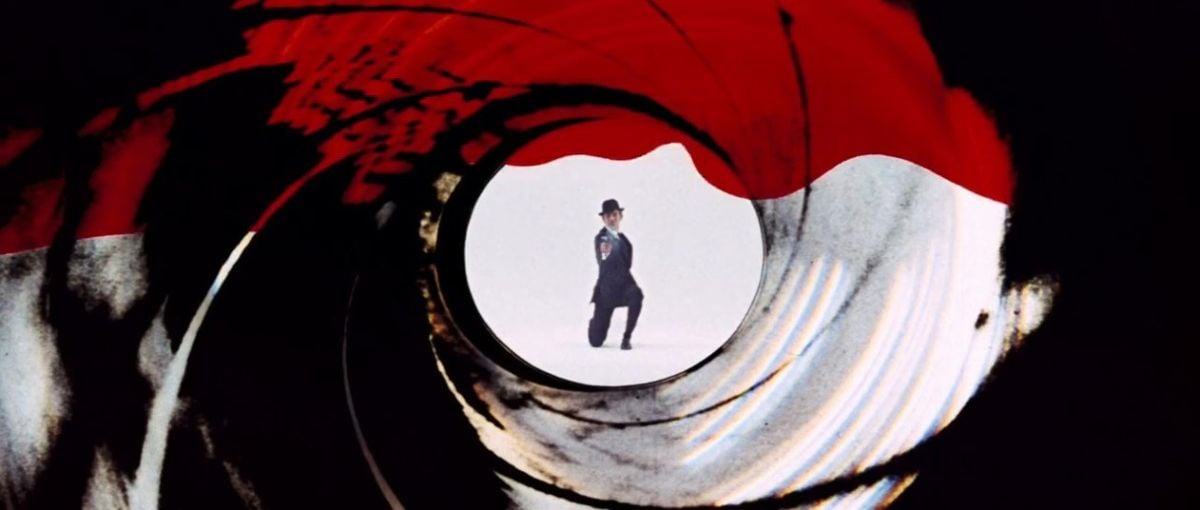
On Her Majesty’s Secret Service: Filming the Thrills, Chills and Spills of 007
How the second unit staged and photographed spectacular action sequences for OHMSS.
By John Glen, Second-Unit Director
I suppose my editing background was my greatest asset when I took over the second unit of On Her Majesty's Secret Service. Peter Hunt, with whom I had worked as a sound editor many years previously, had both surprised and delighted me by offering me this plum assignment.

I arrived in Switzerland in February, when conditions were far from ideal. It was one of the mildest winters on record with very little snowfall. The bobsleigh run, which had been built for the film, was in the process of melting away. Ice blocks were being transported from Bern for building up the walls on the steep banks to prevent the heavy bobsleighs from bursting through. Veteran bobsleigh champion Franz Capose had built the run above Murren on the site of a previous run which had been closed in 1937 after a series of fatal accidents. Franz and his team of Italian workers were fighting day and night to preserve the run for shooting what Peter Hunt had described to me as the most important action sequence in the film.
On the afternoon of my arrival, I inspected the bob run with the long crocodile of my crew slipping and sliding behind me. The weather was foul with low clouds filling the valley. We were able to draw a plan of the course and spot the best camera positions. The run snaked for almost two miles through the public domain with ski trails and footpaths crossing the run via bridges and level crossings. It was while I was thinking of the danger of a child or dog falling into the run during operations that there was a shout and a small boy on a wooden sled came hurtling round the bend and crashed into us. It was obvious that security on the run was going to be a headache, particularly when shooting plates, during which time the run and surroundings should be clear of spectators and lookouts alike.
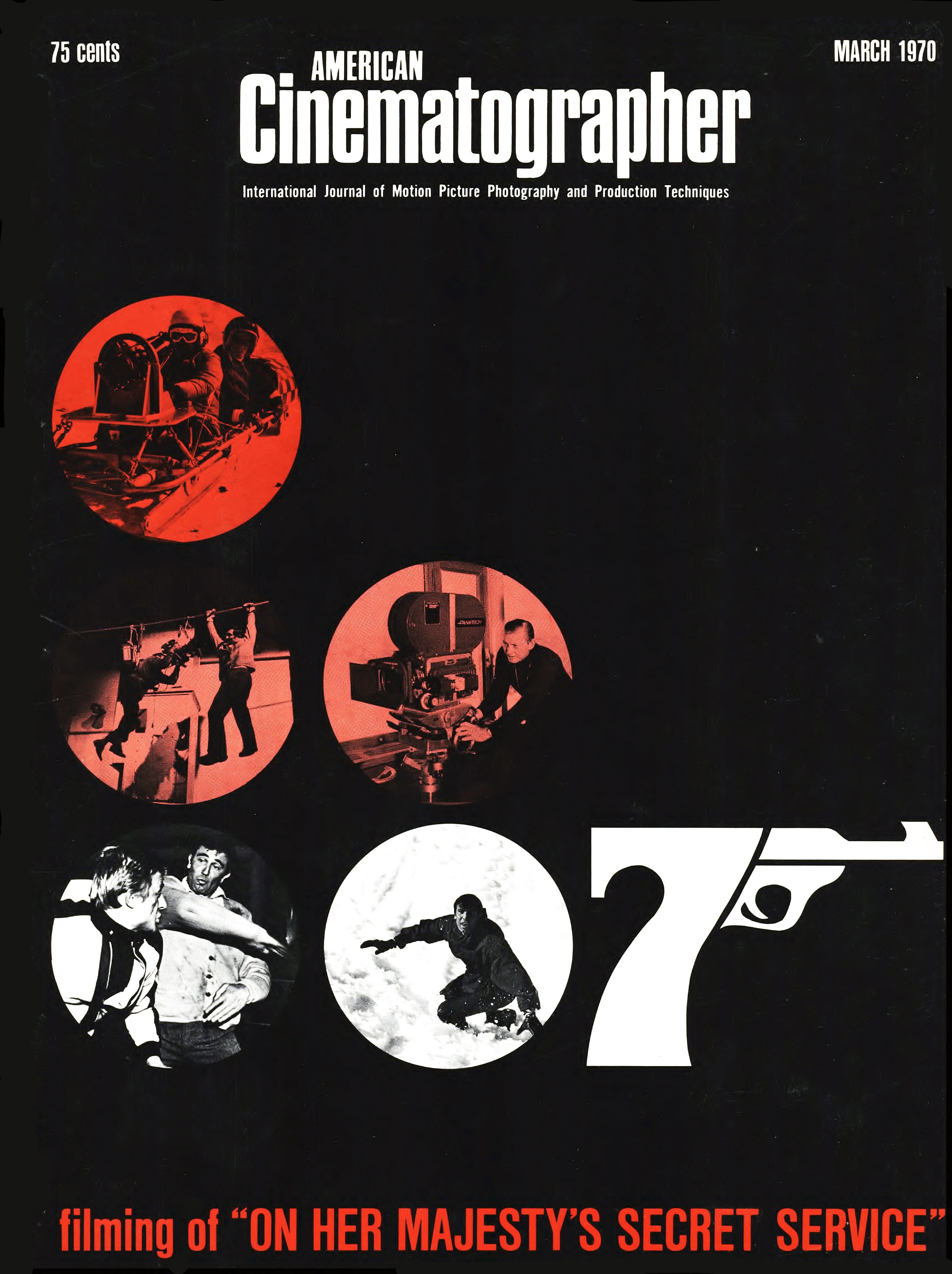
At a meeting that evening I took stock of my crew. Included were John Jordan, the aerial cameraman, and his pilot, John Crudson (John Jordan was tragically to lose his life on his next assignment, while filming Catch 22); Ken Higgins, who was mainly shooting day-for-night material, with his operator, Roy Ford; Alex Barbey, a skiing cameraman from Basle, who was later to prove to be worth his weight in gold, completely unflappable and reliable. Alex was a fanatic in regard to the care he took of his camera. No matter how late we might finish he would check and clean his camera before putting it to bed. Of the vast amount of footage that Alex was to shoot I cannot remember one D.A. or camera fault of any kind.
Willy Bogner, Junior, a skiing champion and amateur filmmaker, completed my camera crew. Willy had made several skiing films himself and developed a unique method of shooting from skis. An Arri was mounted in a lightweight frame with large handgrips and an adapted Hasselblad viewfinder. Willy's skis were pointed at both ends to enable him to ski forwards or backward. By adjusting the viewfinder he was able to hold the camera high for headshots or sling it low and shoot through his legs for rear shots. You can imagine my excitement when I saw this bag of tricks.
John Jordan's fame with his parachute rig was well known and he had become a legend in the village of Murren. John was very keen to use his rig on the bobsled run, flying with his feet brushing the treetops, following the bobs. This operation was bound to be time-consuming as the bobs and helicopter both had to be timed to arrive at the shooting position at precisely the same instant and speed. Time was the main thing I was short of, so I decided to incorporate John Jordan's shots with run-by shots from concealed camera positions on the ground. I asked for all ground units to wear white over suits and have a number of small fir trees available for portable hides.

from weird-looking helicopter rig of his own design, which he used for close "follow shots" of
furious ski and bobsled action down and around the mountain. A strict perfectionist, he accounted for some of the most spectacular footage in this action-packed 007 film adventure.
John Jordan, together with Ted Warringham, our camera mechanic, had been experimenting with a turnover mount for fixing onto the camera bob. We certainly got some very crazy angles with it later. As the workshop was next door we descended on Ted to see what he was up to. The camera bobsled was a four-man chassis with a removable cowling. Ted was making a camera mount that could be fixed fore or aft and withstand the battering it would receive at speeds of 70 mph. We talked about having false cowlings made to place in the foreground to represent the two bobs. Ted worked long hours achieving the impossible.
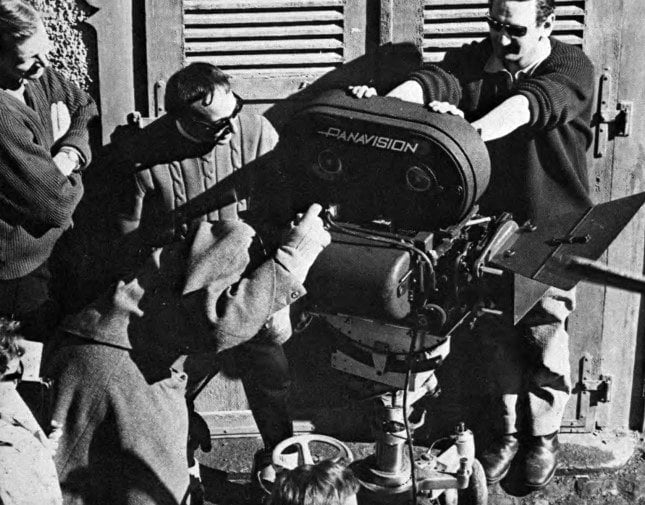
That evening I retired to my hotel room and set to work to produce a shot list for every cut in the sequence. This was to become a very important piece of paper and every member of the unit had a copy. I was most anxious to start shooting the next morning. Unfortunately, Friday had been the regular rest day, and to undo everyone's arrangements at a few hours notice might go towards creating the wrong atmosphere for the uphill task ahead. The crew responded by agreeing to have no regular rest days in the future, only as weather and conditions dictated.
That afternoon I called in Hubert Froehlich who was to become my assistant and organizing wizard. Hubert had been on the picture from the outset and had been responsible for finding the wonderful location for Blofeld's mountain stronghold, Piz Gloria. He knew several languages and was able to communicate freely with the various nationalities on the unit. We talked about the problems that sprang to mind as I became more familiar with the scene. None seemed to present any problem to Hubert. We had first-class radio communication. My only criticism was that it tended to be over-used with small-talk chatter, but it was wonderful to be able to receive the rushes report over the air, talk to John swinging in his harness, check with Willy on the glacier. It was also invaluable for the cueing of cameras and actions and checking security on the bobsled run.
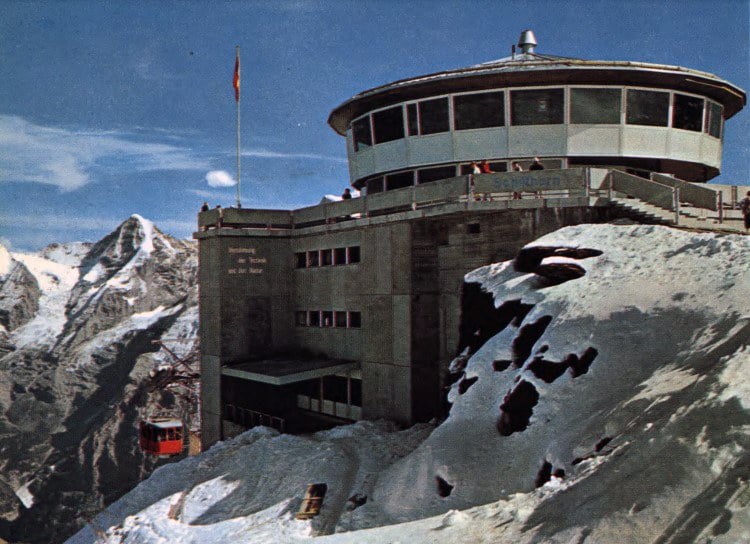
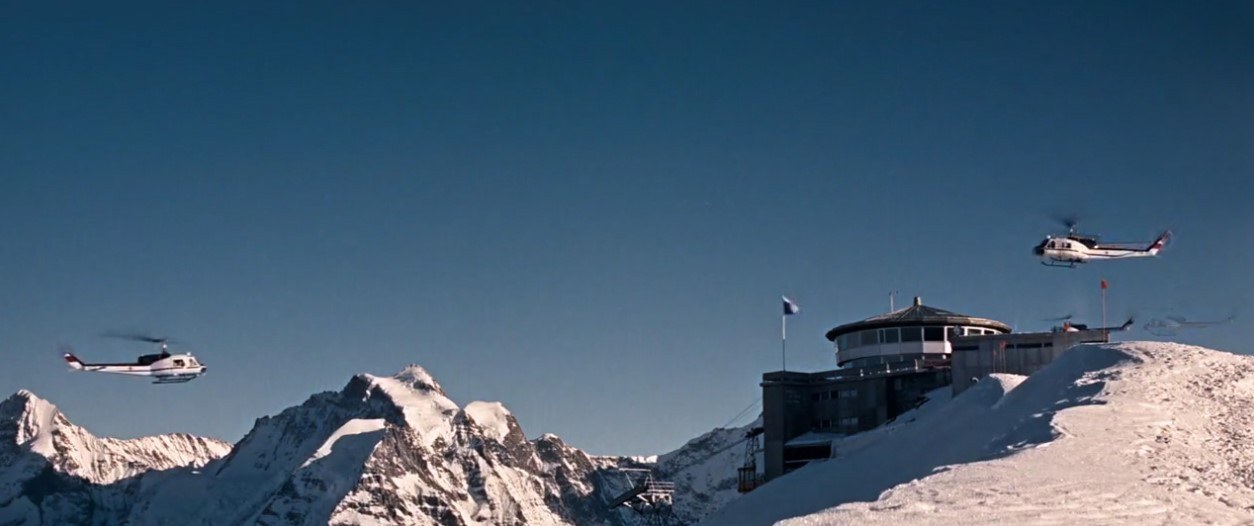
I was interested to find out about the arrangements for staging the avalanche and met Les Hillman, the engineer and special effects man. He was busy on the location checking the wires that were to carry his dummy skiers across the avalanche area. We needed no introductions as I had worked with Les on many occasions in England.
The Swiss army had placed charges high up on the mountain the previous summer and now they should be well buried under the snow. A Swiss expert was retained to give us 24 hours notice when conditions were ideal for blowing. Les was confident his dummies would do their stuff, but it was up to me to cue him at the right moment. A remote avalanche camera had been prepared and was to be placed in the path of the avalanche and turned over by radio control. Alex was to set the camera up and then return to his position by ski. He confided to me that he was worried about the radio control system because, during tests in the workshop, the camera had turned over on the approach of cable cars. I was later to check all five camera positions and conduct a rehearsal.
That evening I went by cable car to Stechelberg and then onto Grindelwald where the main shooting was in progress. Peter Hunt was directing the sequence at the ice rink, which had been built on the local car park. He asked me if I had a good day, and I had to tell him that it was a rest day. It must have been a bitter pill but he swallowed it well. We viewed rushes at the local cinema and afterward had dinner where my shot list for the bobsleigh scene was discussed. Peter, having been an editor, appreciated my approach and thought that if I were able to get half of what I had planned, I would have done well.
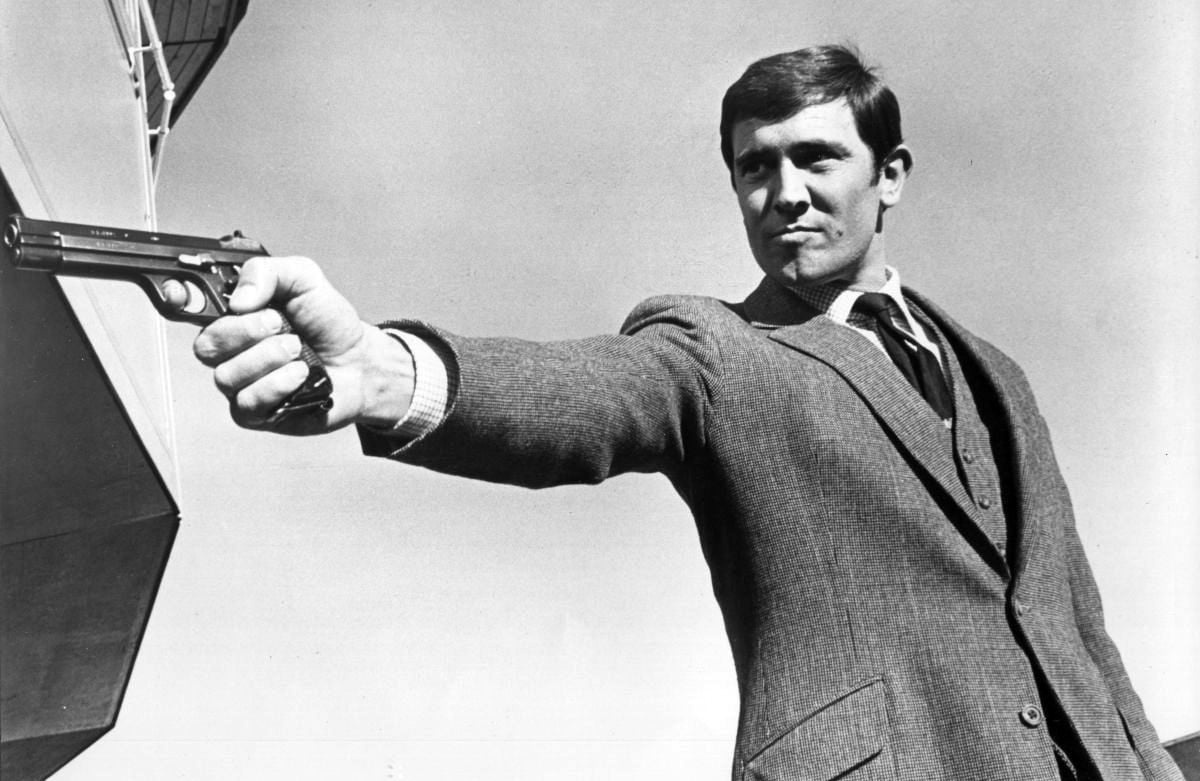
I awoke a fraction before my 5:30 call and hurried to the window. It didn't look too good. The office rang: weather forecast bad. It was my intention in the event of a flat day to shoot tight action on the steepest curve on the bobsled run: Stone Curve. I gave instructions for the equipment and crew to be flown up to this point. We had the good services of two Alouette III's from Air Glaciers of Sion. These were expertly flown by the company's owner Bruno Bagnaud and his fellow pilot Ferdinand. The latter had just completed 2,000 hours in helicopters, so we were in good hands.
By 8 o'clock all were assembled at Stone Curve and I was flown up to join them. I was pleased to see that John Jordan was there. Flying was out that day, but he was determined to get amongst the action. Franz Capose came over and introduced me to his proteges, Heinz Leu and Robert Zimmerman. Heinz, who was to double for Bond, was a champion bobsled driver and a Zurich businessman. Robert was brakeman for the national team and an Olympic skier. Their enthusiasm nearly caused their downfall.
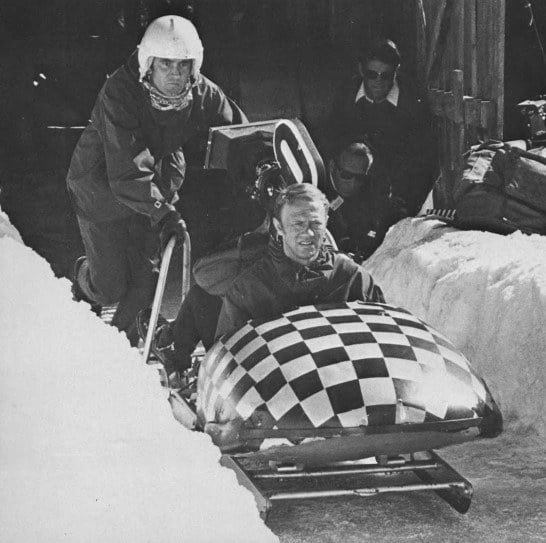
with him in the tiny vehicle, trains the hand-held camera on George Lazenby for push-off of hair-raising chase down the icy run. Leu doubled in long shots of this sequence for Lazenby, who did closer shots against a front-projection screen. Careful attention was given to the shooting of the background plates, in order to assure the resultant perfect match.
Willy volunteered to hand-hold his camera, actually in the run. He pointed out that it would be quite safe, as the bobsleds would be high on the wall, held up there by their speed. We planted a few of our portable fir trees to break up the whiteness, and also to hide Willy's head. The bobs were approaching from a second start, and a lookout gave us the cue for turnover. I exhausted all possibilities for two sleds running through Stone Curve, Bruno with his helicopter, was hovering ready to transport them back to the start. Hubert would control this operation by radio, checking that the run was clear with his lookouts strung out along the track.
We had progressed to the shots of Bond and Blofeld fighting on the one sled. The first take had been too tame. If I had known a little more about bobsleighs I would have realized the difficulty of negotiating Stone Curve while having a punch-up at the same time. I asked them to be more animated if they could. Unfortunately, I couldn't see their reaction over the radio, though they agreed to try. Willy was in his position on the inside of the track as the bobsled approached. They were animated, alright, fighting and punching away while going very fast. Halfway through the curve the front runner went out of the run and an arc of splintered ice came from the top of the wall, as the bob swerved sideways. Heinz was thrown into the run and proceeded along on his backside, still traveling at the rate the bobsled was going when he fell off, while Robert fought to keep the bobsled from falling onto him. When the bob did drop back into the run, Heinz got up without a scratch. Robert was not so fortunate, He got caught in the machinery, suffered injuries to his face and was flown to the doctor where he had stitches inserted inside his mouth.
Two hours later, a swollen-faced Robert reported back for duty. Willy, in the run, had got the whole action with his hand-held camera, and I quickly revised my script to incorporate the new action.
The main problem in shooting the bobsled-run sequences was the fact that when going around the bends the bobs become very, very heavy. If the sun melts the run a bit it turns slushy and dangerous. The runners dig in and you can have terrible accidents if you're not careful. So, with us, it was always a race against time.
Bruno Bagnaud, with his helicopter, was a wonderful help to us in this respect. As soon as a sled finished a run, it was hoisted up by the helicopter and flown straight back to the starting point. Then the helicopter would pick up the bobsled drivers and transport them back so that we could start another run almost immediately. The turnaround was fantastic, like clockwork. It was a real military operation.
During our longest day on the bobsled run, we shot for two and a half hours continuously, filming 18 separate runs. The sled drivers were exhausted because this was far more than they would ever do in a world championship competition.
The weather was to improve dramatically during the next two weeks, and this enabled me to work through my program in weather order. I gave priority to the plates which were to serve backgrounds for the front-projection scenes we would have to shoot later in the studio. This was because experience had taught me that only the best quality of material would reproduce well on the front-projection screen. These plates were shot either by Willy Bogner, using his hand-held Arriflex, or with the camera clamped down onto one of the bobsleds.
We would start shooting at 9 o'clock in the morning (just as the sun cleared the mountains) and continue until about 2 o'clock in the afternoon when Franz Capose said: "No more." Franz, quite rightly, wouldn't risk additional runs under such dangerous conditions. At such time, sun-sails were erected on the bends and further work was restricted to inserts. I would then send Willy up the mountain with a few skiers to shoot plates and POV's.

shooting of follow shot showing Diana Rigg supposedly skiing down the mountain. Specially designed skis, with tips at both ends, aid Bogner in
skiing backwards while he shoots.
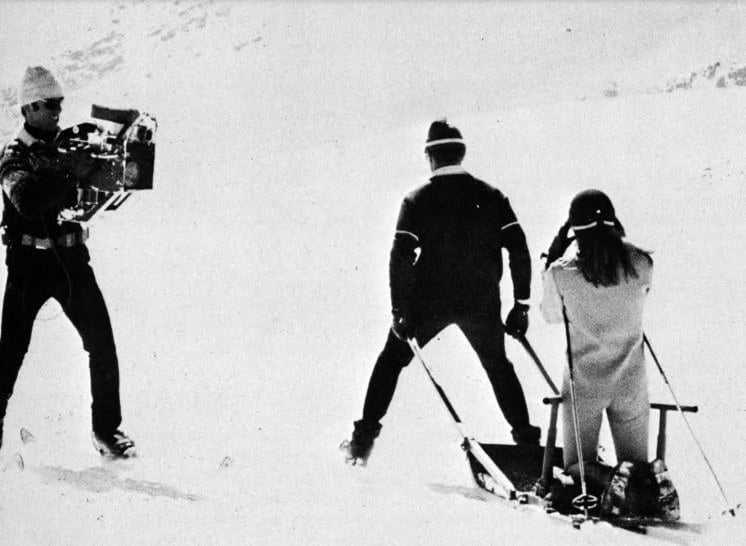
Arriflex camera with a Hasselblad viewfinder mounted on top. Though he is not a professional
cameraman, Bogner's scenes are among the most striking in the picture.
That evening we were scheduled to shoot a "magic hour" car chase at Steckleberg. Five lorry loads of snow had been brought in to dress the corner where Blofeld's car was to spin-off. Alex and I traveled down to join Willy, who was already setting up when we arrived.
Franz Capose was pressing me to close down as much of the run as possible because the sun was creating havoc on the exposed bends. We were now down to one hour's shooting and the height of the walls was visibly diminishing. Fortunately, our quick turnaround was paying dividends.
Willy told us that he thought he could ski in the bobsled-run, and it turned out that he could — which was incredible! All we had to do was provide an exit for him. We cut out a sort of ramp at the side of the run so that he could get off of it.
For comparison, we would first send a bobsled down the run with a camera mounted on it. As soon as it was out of sight, Willy would charge off on his own and do all sorts of strange things. His footage proved to be the smoothest because he could lean forward with that contraption of his and get the camera right down onto the bottom of the run. He used a 40mm lens most of the time.
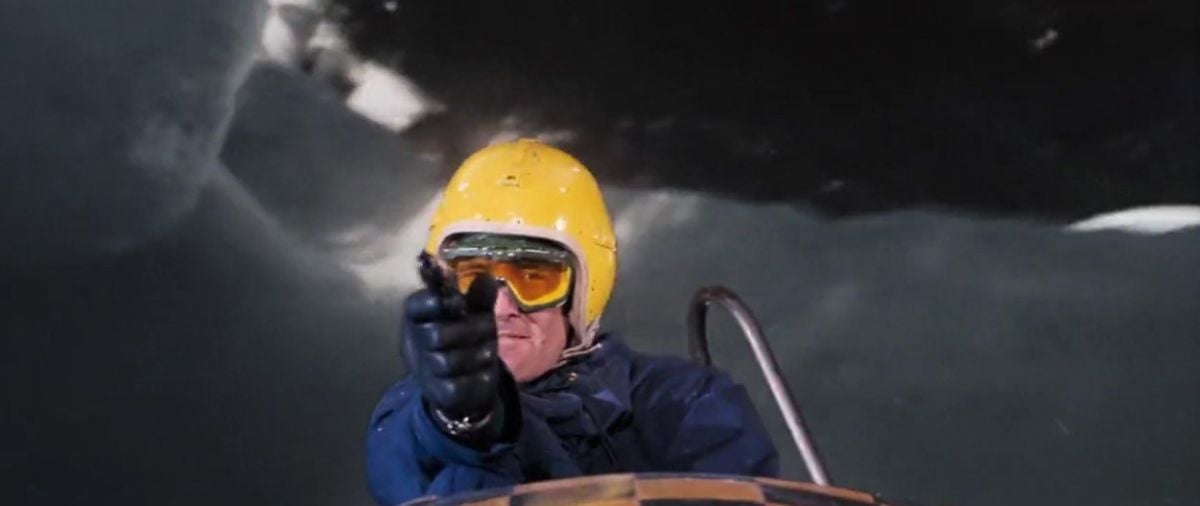
Later on, when we came to do rear shots of the men fighting on the bobsled, Willy took out after them. However, he couldn't keep up with the bob because it was much heavier than he was. It's weight that counts on a bobrun. The heavier something is, the faster it goes.
We ended up by tying Willy to the back of the bobsled, by means of a cable 20 feet long. This was very effective because, not only could he maintain a constant distance, but he was able to get over-the-shoulder shots, as well. We rigged him out with a sort of quick-release for the cable (a stick stuck into his battery belt) which would at least give him some way of escape. If he got into trouble, all he would have to do was knock the stick out of his belt.
John Jordan's turn-over camera mount was also proving that it could accomplish some very exciting shots. John would take off his artificial leg and tuck himself into the front of the camera-bob. Heinz would sit close behind him with the steering ropes on either side of John, while Robert rode the brake. The track was now so bad that I decided to shoot with the sun sails up to afford the bends maximum protection. We were winning, however, and I was soon able to close some bends down, which gave Franz a better chance to concentrate on the lower sections of the track.
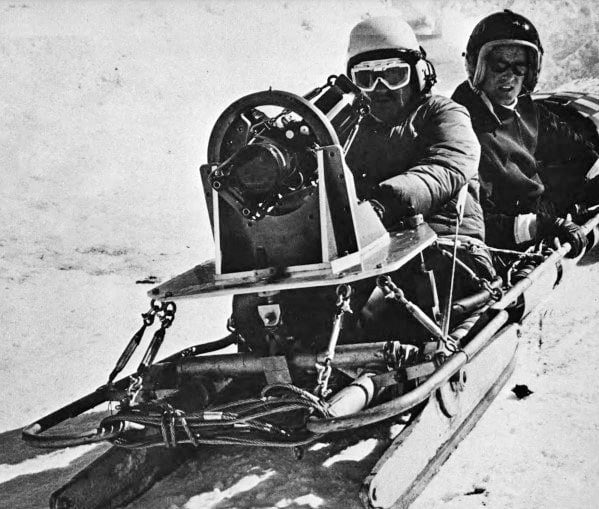
which he helped design and which permitted the camera to be rotated for realistic filming of
"spin-out" scenes.
There were still a few stunts that had to take place, the easiest of these being when Bond is blown out of the track by a hand grenade. Heinz, who volunteered to do this stunt, inspected the run and made a mark where he was going to jump, I was going to press the button to detonate the explosive buried in the track. A wall of snow was built further down the run to halt the runaway sled.
Heinz prepared his exit by somewhat surprisingly having the soft snow beaten down hard. With four cameras at the ready Heinz made his way to the start. A last-minute adjustment by Alex nearly caused a disaster. The grenade lying in the track was not showing too well so a reflector was positioned. When Heinz came sweeping round the curve, looking for his mark to jump, all he could see was the dazzle of the reflector. He jumped at the same moment that I pressed the detonator and he skidded along the parapet, finishing up between Hubert's legs, none the worse for wear. Afterwards, he told me that it was just as well that I pressed the button when I did as he had no idea where he was. About this time we heard a sound like thunder and word came through that our avalanche had come down of its own accord.
The scene toward the end of the bob-run sequence, in which Blofeld's head gets caught in a tree branch overhanging the run was proving to be very difficult to shoot successfully. Our stuntmen were putting their faith in a cable attached to Joe Powell's back by means of a harness, with a shock absorber anchored to a tree. It looked terribly dangerous to me and much too complicated. On the take the cable broke from the harness and Joe smacked the tree with a terrible bang and fell on his back into the run. None of us fancied trying that one a second time.
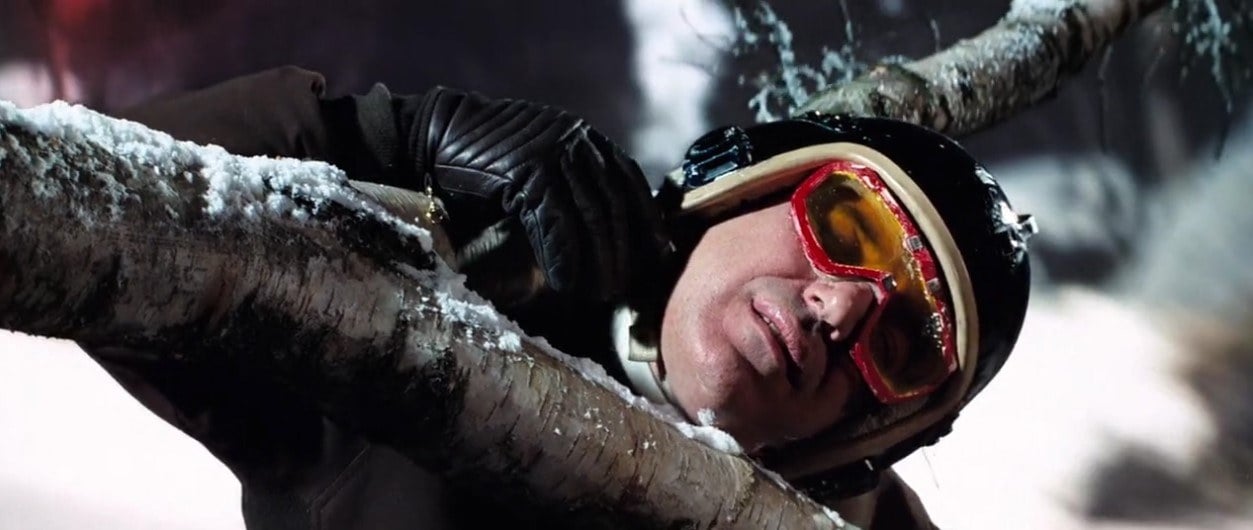
Peter eventually solved the problem with front-projection. Shooting with the camera reversed, he had the artist lowered down from the branch in front of one of our moving plates and finished with a frame cut right there. This rather brutal scene gets a very good laugh in the cinemas because the excitement has built to such a pitch that the audience welcomes something to release the tension.
The most dangerous stunt — that in which Bond was to leave the run in his sled — was last on my list. Again, Heinz volunteered. Franz Capose had marked the bend with red markers to describe the course Heinz was to steer. It meant approaching at maximum speed to hit high on the banking, then to steer the bob down to the bottom and up again. If Heinz followed the line that Franz had made, the bob would leave the track and turn outwards to allow Heinz to jump clear. I worked out my camera positions accordingly, as this was one stunt I did not want to repeat. On the first take, Heinz lost his nerve and jumped too early. The bob continued along the parapet for quite a distance before leaving the run, narrowly missing a camera. The next attempt was scheduled for the next good-weather morning.
By then, Heinz and Robert had worked out a different scheme. Robert was to steer to allow Heinz to concentrate on the jump. Robert was to fall back into the run. This time the bob came out at the exact spot Franz had indicated but, unfortunately, Robert was in the shot on two cameras. I did one more take with an empty bob, Robert having steered out and dropped into the run, and got a very-slow-motion shot of the bob in flight.
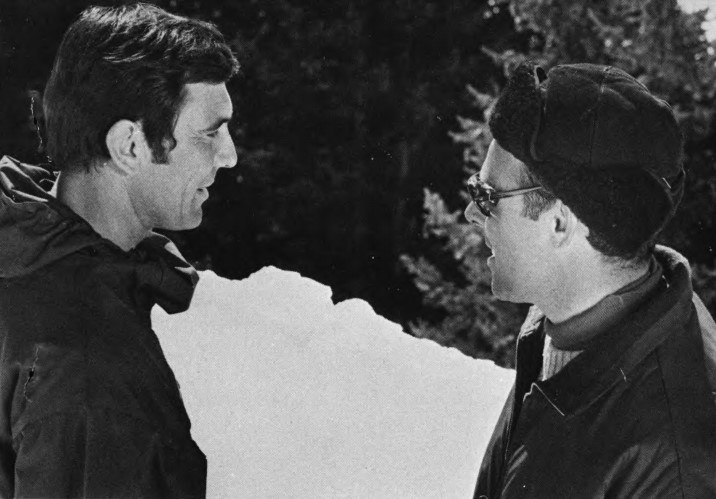
and get a great boost from having the star on hand.
Heinz volunteered to do another take, but by this time I had a nasty feeling about this stunt. I decided to wait for rushes, it turned out that we were not to get another chance, the decision was taken from me as the weather beat us.
Now I was shooting inserts in a 'tent'. With the snow falling fast, a sheet was stretched across the bob-run and, with the aid of Sun-Guns, we filmed close shots of the steering ropes and brake, bullets hitting the cowling, etc. These shots proved very useful on two counts. For a snowbound unit, morale can drop very quickly. The whole unit had a lot of fun doing these shots, filling in time usefully.
Diana Rigg arrived at Murren in the middle of a snowstorm to do pickups. It was a wonderful day and I think Diana enjoyed it as much as we did. As if there wasn't enough snow about, we created some with a snow plough and proceeded to shoot insert avalanche shots. The turnover head was very useful and we got some “for real”-looking shots.

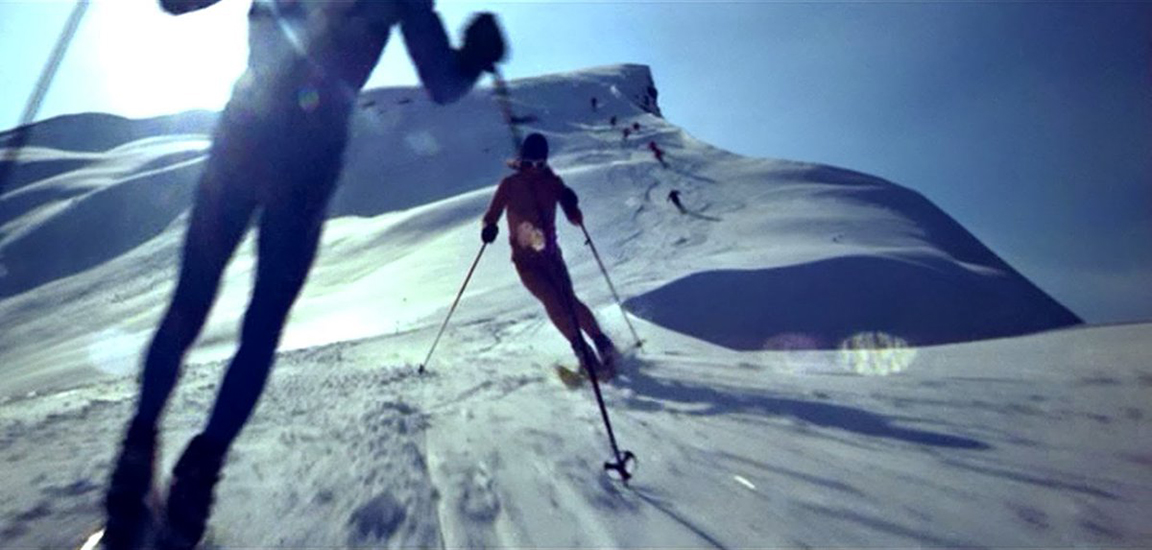
For a second unit to have the star with it is a great boost and we were all in high spirits. Diana went down to the village by sledge. Heinz had been entrusted with her suitcase and he and his crowd had 'borrowed' a hornsled from a farmer's barn. The farmer gave chase and there was a great chase down the mountain. Diana's suitcase was 20 yards in front at one time. I travelled down on Willy's back. Skiing on someone's back is rather like riding a pendulum and in time my nerve gave way and I abandoned ship. With my trousers full of snow I continued the journey riding the rear of his skis, which I found more comfortable.
After seeing Diana off I joined the crew at the Alpenrihre for some coffee and there was Heinz with the farmer getting very drunk on the 60 francs Heinz had paid him for smashing up his hornsled.
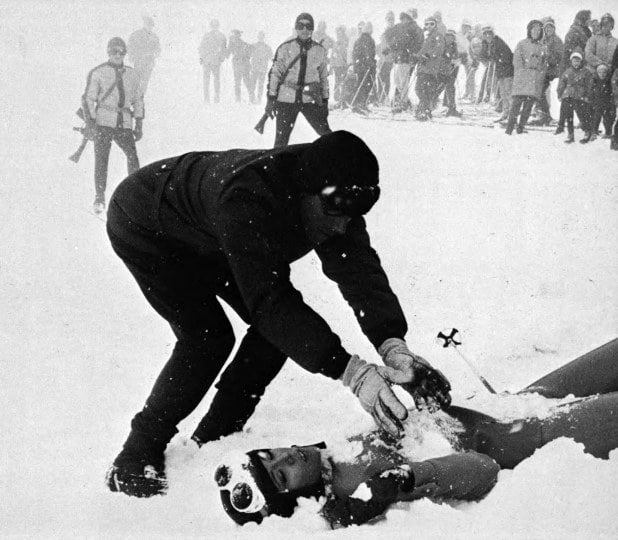
from the avalanche. Curious bystanders had a field day watching movie crew at work.
The weather continued to be bad but I managed to shoot the post-avalanche scenes in the debris of our avalanche and began experimenting with tumbling bodies in the centre of the avalanche. On the top slope, with the aid of a snow plough and great banks of snow held back by barn doors, I placed the doubles in position, planted trees in foreground and background, and then I let everything go. With the snow falling fast and the background completely white the shots looked extremely real. I tried using the helicopter on one occasion to get the blowing effect. It blew us all over everything, cameras and all.
We were to have one last go at blowing the avalanche, because there had been some new snow and I thought it worth a try. There was a slight break in the weather and, thanks to our rehearsals, we were able to arrange it at short notice.
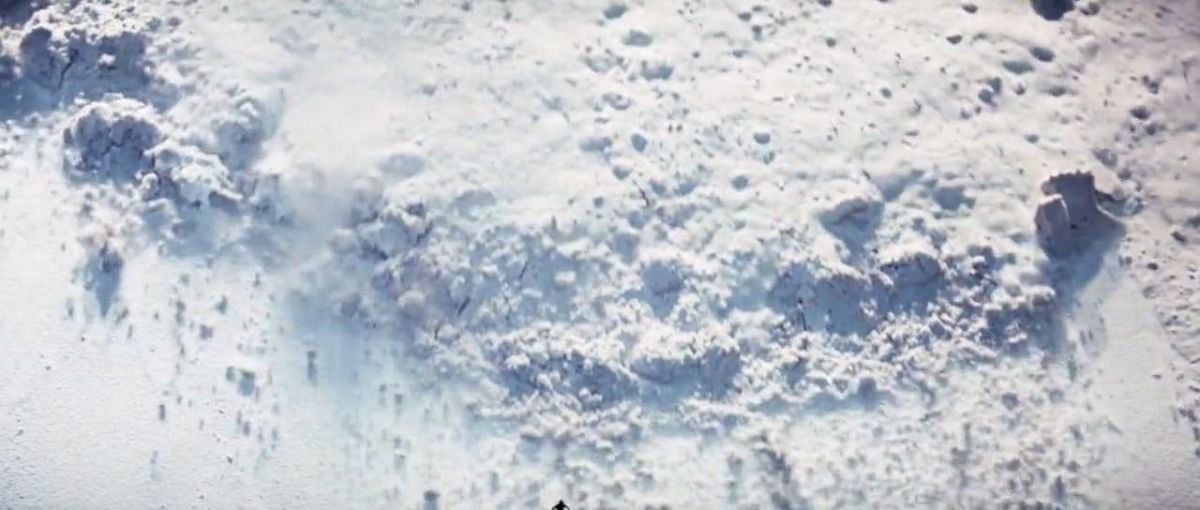
The camera crew was flown into position and we were ready to shoot by 10 o'clock. I gave the turnover and fired the charges. Nothing! Then, slowly, a miserable slide started. I waited for a while for something to develop. When it became obvious that was it, I cued Les to let dummies go. I saw them start, go a few yards and two fell off the wire, the remaining one then accelerated across on its own. I could have cried for Les who had spent so much time and energy on this project.
At a later time, strictly by chance, we were able to get a shot that somewhat made up for the failure of the dummies. I had been filming some extreme long shots of skiers traversing through the avalanche area. The snow condition was so bad that even the experts were having trouble. In one of the shots, three girls were going through the area and they fell — one right after the other. This hadn't been intended at all. But it was a simple matter, when we got back to the studio, to matte in one of our avalanche shots so that the torrent of snow seemed to roll right over them and cover them up.

Avalanches are the most unpredictable of things and I was to learn when I returned to Switzerland a few weeks later why mountain people have such respect for them.
The snow plough scene had been attached to a train in the book, and although we had tried to keep to the original narrative as closely as possible, it was just not on. Hubert came up with a scheme to change it to a huge, tracked road vehicle which was to be used to clear the high passes in the spring. As this was also the best time for avalanches, we were to try for that as well.
Shooting the snow plough scene went very smoothly. We were a small unit and moved as only a small unit can. We would start very early and work until 2:00 p.m. when the slides and avalanches would start. The road was 20 feet under the snow at the point where we were working.
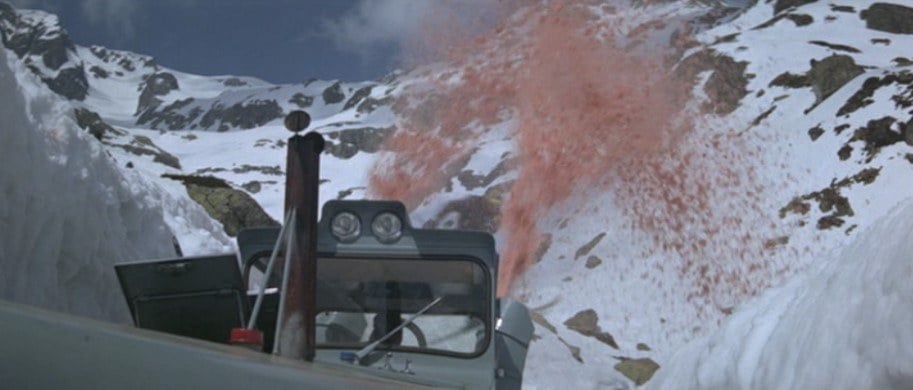
A smaller snow plough would precede us in the morning clearing the road to the location, the large snow plough was parked under a natural bridge. We had a look-out stationed above where we were working, watching for slides. He was to sound a klaxon at the first sign of danger. We were busy down in our trench with the snow plough engines making a thunderous din when one of the Italian workers appeared waving his arms and trying to shout above the noise of the plough. We got the message and scrambled out. A slide came and filled up the trench and then continued down the mountain. Fortunately, it missed the snow plough. Alex had snatched the camera out of the way, but the batteries had been covered.
We moved back to Murren to complete the night ski chase. Peter had been worried about the difficulty of identifying the two groups of pursuers in the night chase and I was to shoot several master shots to establish the relationship of the various groups. Also, there was a flare sequence in the script which I hoped to shoot. It was whilst shooting tests with hand flares that I noticed how effective skiing between trees, holding hand flares was. I contacted Peter who was now filming in Portugal and got his approval to adapt the scene to include one group of pursuers with hand-flares, whilst the Blofeld group would fire a parachute flare. This would make identification very simple and, at the same time, give more variety to the sequence. Filming this action involved five evenings of magic-hour shooting at Winteregg, where there was still plenty of snow. A narrow tractor-type vehicle took us to the slopes and then we transferred to a snowcat, whose drivers sole object seemed to be to throw off as many members of the crew as possible. The snowcat, a remarkable vehicle, appeared to stand on its head at times. Where Bond is illuminated by Blofeld's flare we used 10 flares raised on a pole and fired electrically for the flare effect. Light took some time to build up, but then held steady for two minutes.
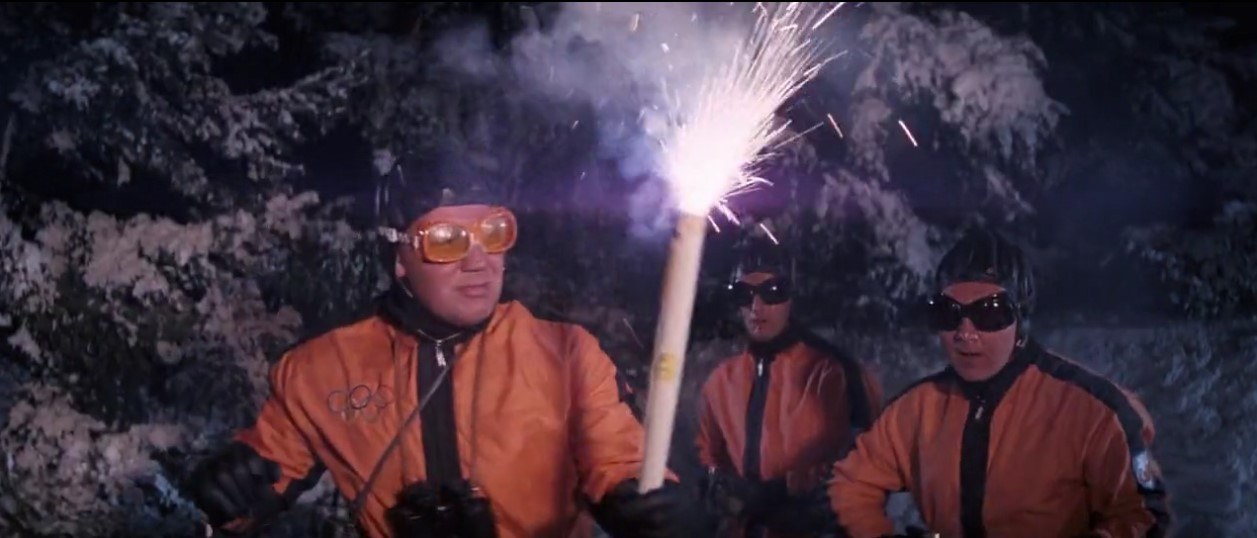
We were shooting day-for-night in this sequence, having to cope with a range of contrast from glaring snow to deep shadows cast by trees, while keeping straight the geography of three separate groups racing at top speed down the mountain. What you hope for in shooting such intricate action is that you will get all of the bits and pieces which, when joined together skillfully, will add up to the total impression the script calls for.
Most of our scenes were shot in one, two or three takes — and there was a bit that could be used nearly every time. You might have to go again for a particular piece of the action that hadn't come off, but it was rarely necessary to go again for the whole scene. We printed nearly everything we shot.

day -for-night ski chase, one of the most intricate and spectacular action sequences ever recorded on
film. Ski champion Willy Bogner, keeping pace with the zig-zagging skiers while shooting with
hand-held camera, captured some of the most exciting footage for this sequence.
When you look at such scenes in the rushes you have to look at them with a trained eye, an editor's eye, actually — because perhaps 70 percent or more of the shot will be unusable. Taken as a whole, the stuff may not look impressive in rushes, but it's a matter of picking your bits. The uninitiated will tend to look at a shot in its entirety and judge it in its entirety. Very few realize that you may be able to extract two feet, or even one foot that is valuable. Nearly all of Willy Bogner's stuff was hit and miss, taken as a whole — but in amongst that material were rare gems that could be picked out and joined together to create some wonderful impressions.
We were now into May and there wasn't a trace of snow left at Murren. I noticed cows grazing where the bob run had been. The following day it started to snow heavily and didn't stop for two days. This was very good for our avalanche chances. We carried out a reconnaissance the next day in a deserted valley near Murren. Hubert contacted Bruno, our helicopter pilot, and arranged for him to fly over from Sion the following day. Charges were prepared and the next morning we set out to rendezvous with Bruno. Shortly after 10 o'clock, the helicopter arrived and began to ferry us to the location. It was a perfect day and very hot with four feet of new snow on the fields above us. We all felt very confident. We had found a good camera position on high ground in the center of the valley which gave us a commanding view of snowfields on the mountains above us. Bruno and our guides began to plant their charges with 2-1/2-minute fuses.
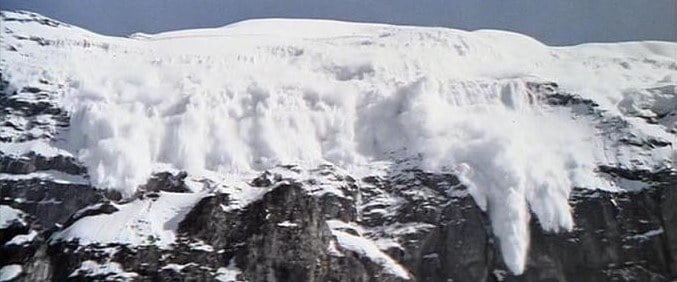
As soon as the fuses were dropped, the helicopter retired from the skyline while we made our countdown. We saw the explosion first, and the sound followed. Thousands of tons of snow came thundering down. This was more like it. Systematically we worked our way around the valley and got a number of very fine shots. Conditions were so ideal that avalanches were starting without charges and we got a few bonus shots.
We were now down to our last four charges. I had been looking at a large snowfield that remained untouched, spreading down the valley for a couple of miles. It would mean changing position to get the best setup, so Bruno came down and transferred us to a new position. It looked like it would make a great shot against a perfectly blue sky, but at that moment a jet passed by leaving a vapour trail through our shot. Such is life.
The helicopter passed across the snowfield and dropped the charges. By this time we were not turning over the camera until we saw the first explosion. It seemed like the whole mountainside was coming down. The slides rippled out from our explosions and started to crash down as one. Two miles away at our base people who came to watch were running away. All this and only one camera.
I called to Alex to pan, because he was using the 50mm-120mm zoom and needed a wider angle. His assistant was adjusting a flag to keep the sun off the lens and at one time it came into shot. Alex's hand came up and knocked it out of the way. The next moment the ground shook as the avalanche hit the valley floor. Out of the corner of my eye, I was aware of Hubert trying to run back towards us from his vantage point at the edge. All at once, a great cloud of snow came roaring up. Alex came out from behind his camera, calmly assessed the situation, and put his head back to his camera.
Now it was a question of hanging on to your hats as the wind came, but we had a wonderful feeling that the worst was over as the sun began to filter through the swirling mist of powder snow. We were changing magazines when the river of snow was emptying into the valley and we just caught the last part.
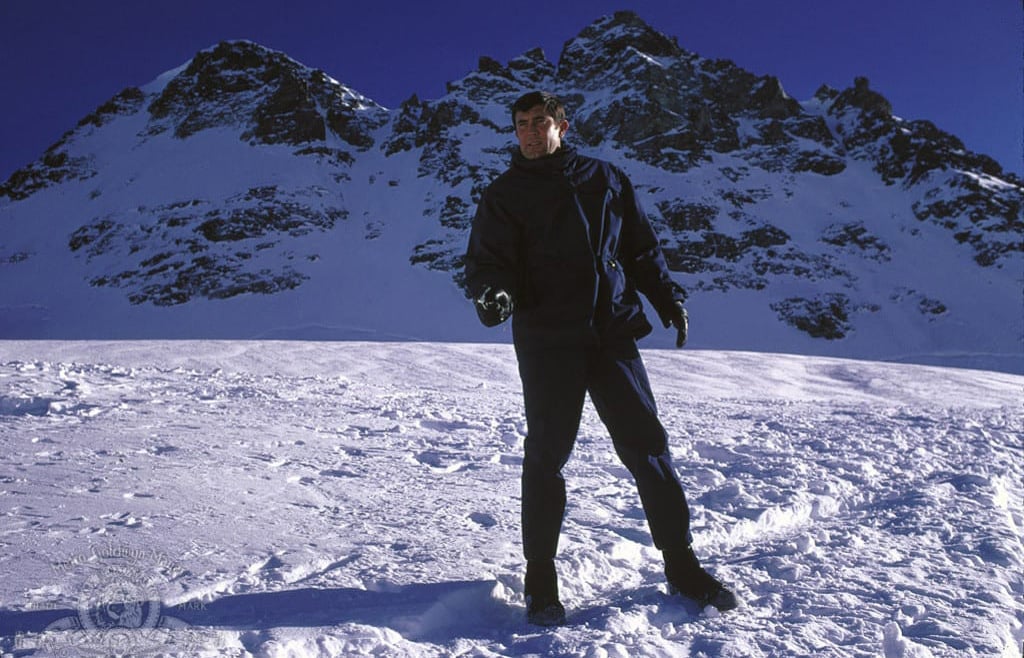
It was a memorable end to a most exciting assignment. I have a feeling that after this latest encounter with James Bond, 1970 is going to seem a quiet year.
After overseeing second-unit work on the subsequent 007 adventures The Spy Who Loved Me and Moonraker, John Glen would go on to direct For Your Eyes Only, Octopussy, A View to A Kill, The Living Daylights and License to Kill.
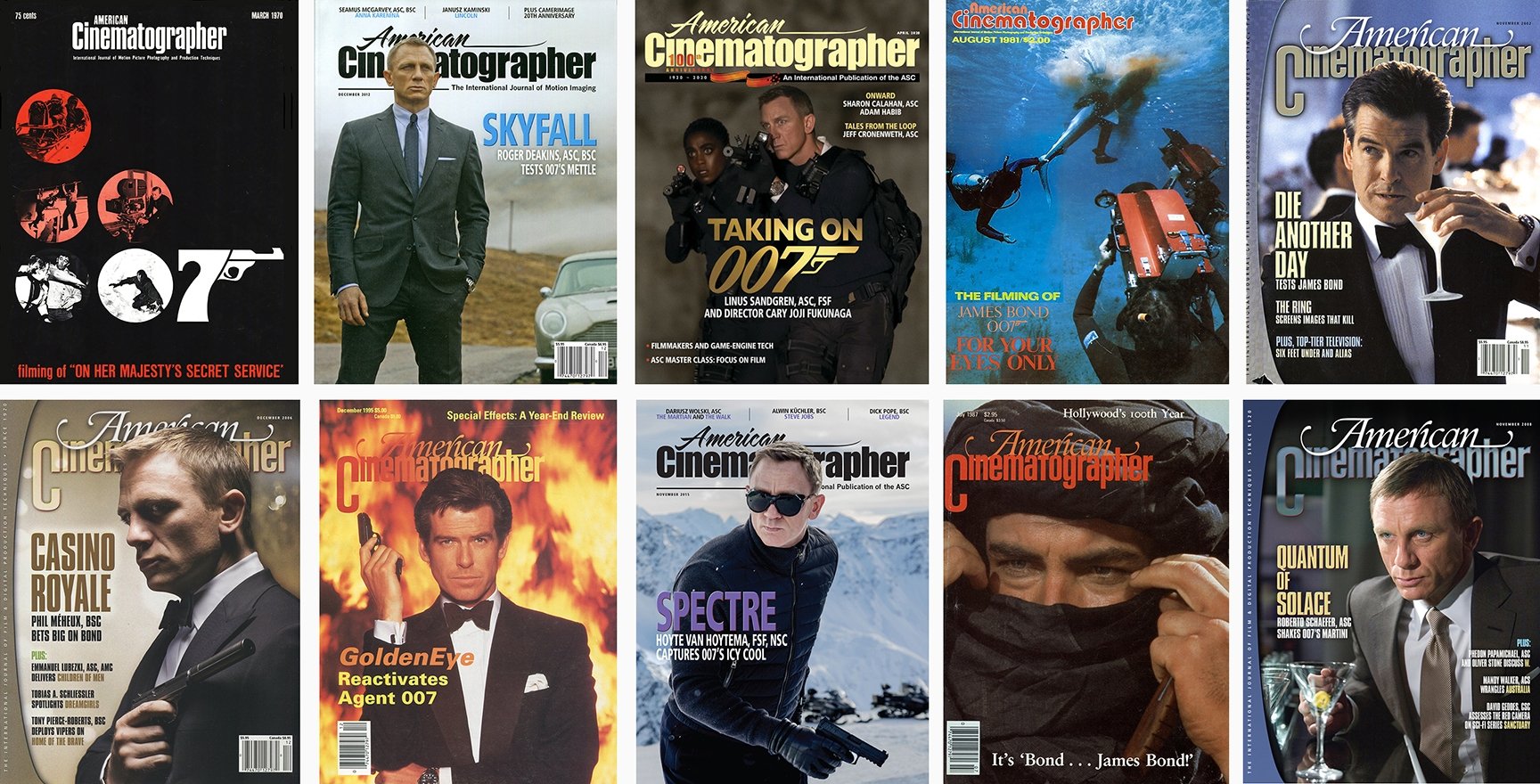
You’ll find more of AC’s 007 coverage
from our archives here.
